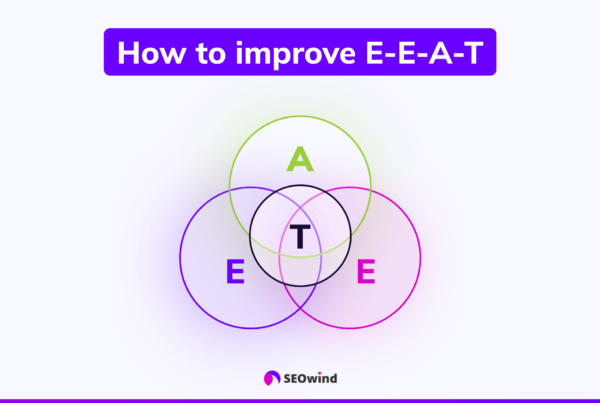Standing out from the crowd and ranking well on search engines is a monumental challenge. Crafting an exceptional content strategy can significantly enhance organic search traffic and your visibility on the web. Well-designed pillar pages prove highly effective in this regard. This article delves into various excellent pillar page examples that will provide valuable insights for mastering your content strategy.
What is a pillar page example?

Pillar page examples are templates showcasing best practices in design, organization, SEO optimization, user experience (UX), and content quality. By analyzing these examples, you can glean insights to refine your approach when creating high-performing pillar pages that elevate your content strategy and propel website engagement through the roof.
What is a Pillar Page?
A pillar page is a comprehensive resource covering all aspects of a specific topic or theme. It is the cornerstone of your website’s content architecture, linking multiple blog posts or articles related to that central topic. These linked posts form what are known as topic clusters around the primary subject matter. By providing in-depth information and organizing it systematically via your pillar and cluster pages, you offer immense value to readers and earn favor from search engine algorithms.
Types of Pillar Pages: 10x & Sub-Topic Pillar Pages
Before diving into the various pillar page examples, it is crucial to understand the different types of pillar pages that exist within content marketing. Each pillar page type serves a unique purpose and employs distinct information presentation techniques. Examining these categories allows you to develop a comprehensive strategy tailored to your audience’s needs and preferences.
10X Content Pillar Page
A 10X content pillar page is designed to provide ten times more value than competing resources in depth, breadth, or quality by offering in-depth analysis or frequently updated data on a subject matter. Creating such a comprehensive resource enables you to become a topical authority and appeal to search engines clamoring for fresh, high-quality information.
Some critical components of 10X content pillar pages include:
- Thorough research from reliable sources
- Visually appealing multimedia elements, such as infographics or videos
- Comprehensive explanations with engaging storytelling techniques
- Distinct organization and structure for easy navigation
Sub-Topic Pillar Page
Rather than hub pages covering broad topic, like 10X content, sub-topic pillar pages focus on individual aspects within a more significant theme. These pages are essential for targeting niche audiences while maintaining relevance within your overall topic cluster strategy. The aim here is to showcase your depth of knowledge and expertise in multiple related areas.
When crafting sub-topic pillar pages:
- Identify significant themes within your industry
- Research specific keyword phrases relating to each theme
- Write concise yet informative blog articles addressing those targeted keywords
- Provide clear, actionable insights or solutions for each issue
- Incorporate multimedia elements to enhance the reader’s understanding of the topic (e.g., infographics, videos)
- Interlink all relevant sub-topic pages within a broader pillar page
What are the types of pillar pages in content marketing?
While developing a comprehensive content strategy, it is crucial to understand the various types of pillar pages used in content marketing. This knowledge will help you determine which example of content pillars works best with your brand’s objectives and target audience. There are three main types of pillar pages: 1) resource, 2) guide, and 3) product/service.
Resource Pillar Page Examples
Resource-based pillar pages focus on providing valuable resources for your website visitors. These pillar page examples compile helpful tools, tips, or assets related to your industry or niche expertise. As an authority within your field, compiling a list of top resources can have multiple benefits:
- Reflecting on your transparency and expertise
- Offering added value for readers who seek information within your niche
- Enhancing SEO through strategically placed internal and external links
Here is an example of a resource pillar page – HubSpot’s Essential Guide to Marketing Automation.
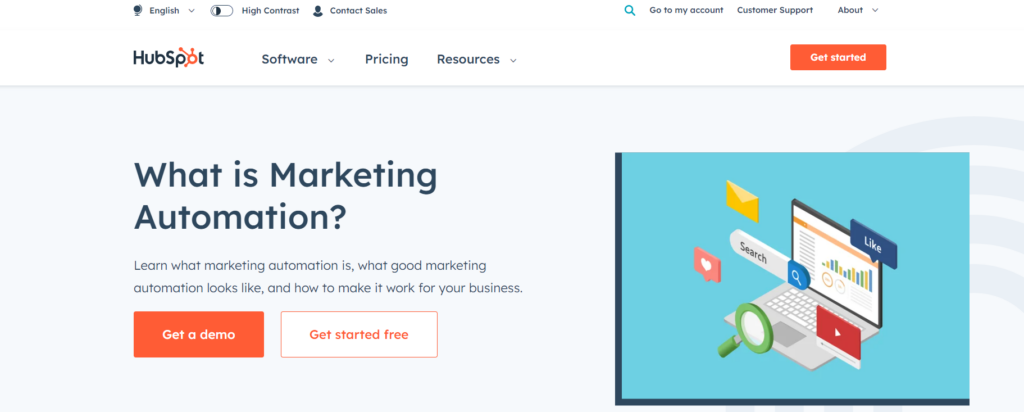
Guide Pillar Page Examples
Guide-pillar pages offer an extensive, comprehensive look at a specific topic relevant to your business or industry – acting as detailed tutorials or walkthroughs. These strategic pillar examples include long-form content that breaks complex concepts into easily digestible sections. Standard components often feature how-to guides and step-by-step explanations designed to educate beginners and advanced users.
A prime example of a guide-pillar page is Moz’s Beginners Guide to SEO.
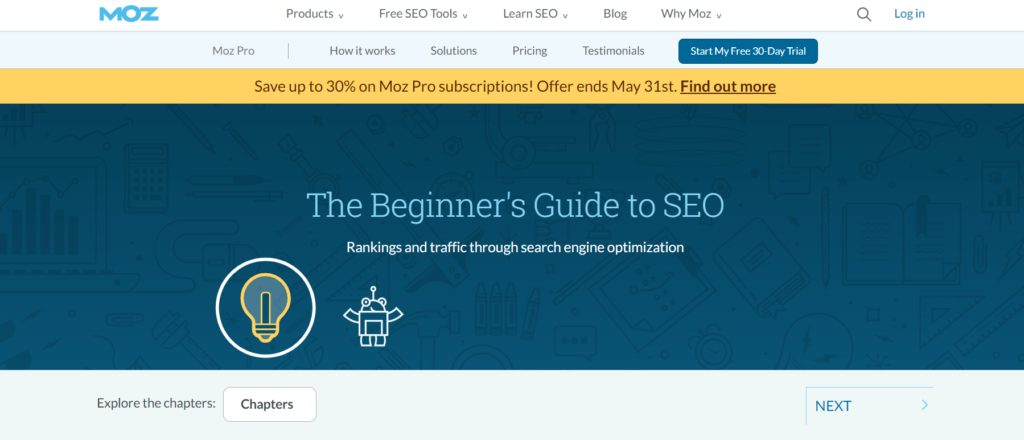
Product/Service Pillar Page Example
Product or service-centered pillar pages provide detailed information about the offerings directly related to your business. Unlike traditional sales materials focused solely on promotional language or transactional engagement, these best pillar-page examples emphasize education and value-adding insights.
These pages should address customer pain points while showcasing solutions provided by your products or services. High-quality visuals, testimonials, and additional resources can strengthen their effectiveness.
One example is the Salesforce CRM page, which expertly uses content to connect with prospects while offering valuable insights.
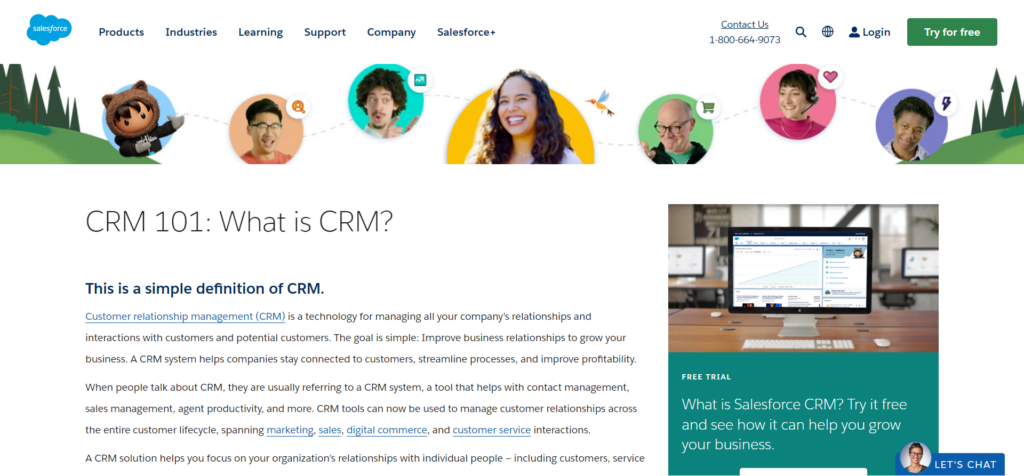
Now that you have a deeper understanding of the different types of pillar pages in content marketing, it’s crucial to pinpoint which approach aligns best with your brand goals and specific targeting requirements. From resource compilations to expert guides and product-focused pages, each strategic pillar example has unique benefits – all aimed at bolstering your overall content strategy.
8 High-Performing Examples to Draw Inspiration From
Let’s examine some accomplished examples. Here are 8 high-performing pillar page examples that showcase a variety of engaging elements:
Best Overall: The Ultimate Guide to the Best Productivity Apps from HubSpot

This exceptional example of a pillar page combines visually appealing design, well-structured content, and easily navigable sections for users. Their comprehensive guide on productivity apps addresses various user questions and provides valuable insights. To create your successful pillar page, consider integrating these features.
Best Data Visualization: Population Healthier from The Atlantic
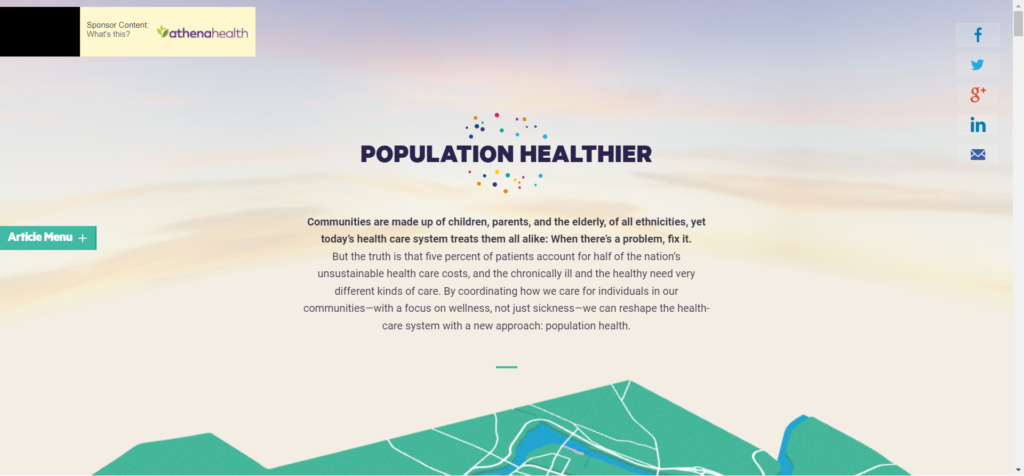
Population Healthier stands as an exemplary example of data visualization in pillar pages. This engaging content showcases vital health statistics through interactive graphs and charts, making it easy to understand and fascinating for readers.
Best User-Friendly: A keto diet for Beginners by DietDoctor
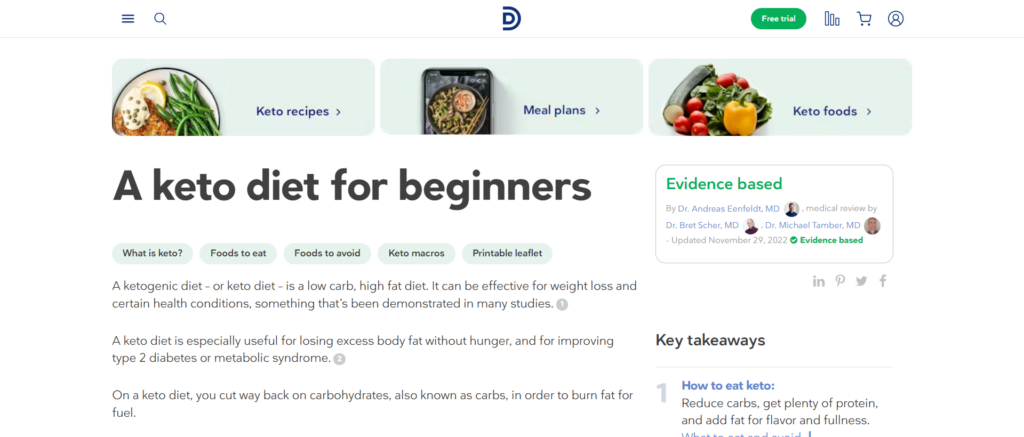
With clear headings, key points, informative images, and videos embedded throughout the article, this pillar page is an invaluable resource for people wanting to try the keto diet.
Best Navigation and Text: The Complete Guide to Outsourcing Your Electronics Manufacturing from JJS
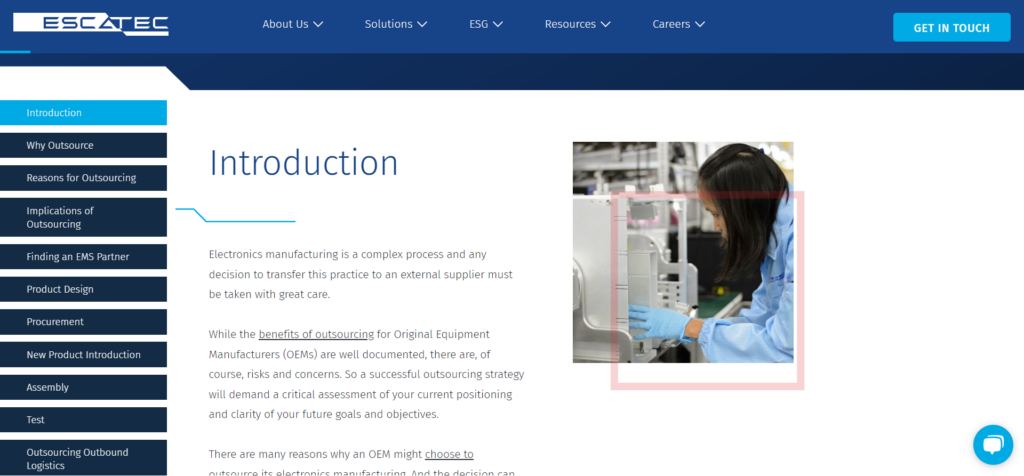
JJS Manufacturing presents information sequentially while allowing users to jump between relevant sections through convenient navigation. This approach simplifies complex subject matter without sacrificing depth or authority.
Best Guide: Everything you need to know about SEO Content Brief
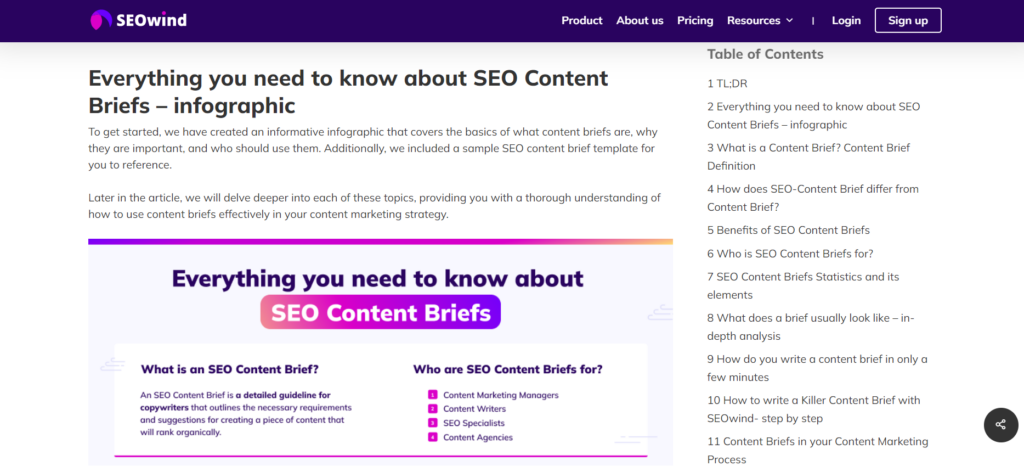
A comprehensive guide on content briefs covering all the aspects: from what it is and its benefits to statistics and how to create and include it in the content writing process. Moreover, you can find infographics and videos, making it easier to understand the importance of content briefs.
Best Storytelling: Battle of the Bots from HubSpot

HubSpot successfully crafts a narrative around their topic—chatbots—with this remarkable example of storytelling on a simple pillar page alone. By using different multimedia formats like podcasts and eye-catching images, they keep readers engaged while showcasing their expertise in AI technology and chatbot development.
Best Use of Simplicity: The Content Marketer’s Ultimate Guide to Search Engine Optimization from Bluleadz
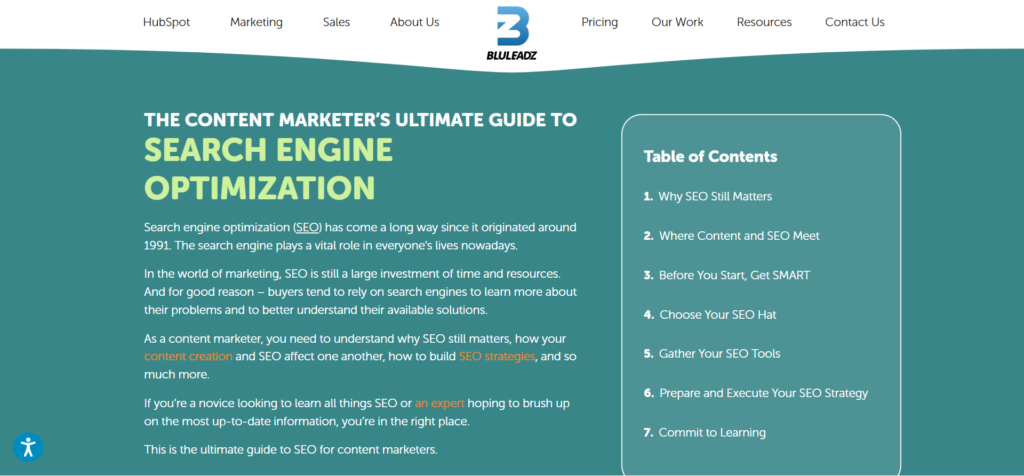
Simplicity is vital in making complex topics more accessible, as evident in Bluleadz’s informative yet digestible SEO guide. This pillar page breaks down essential information into comprehensible sections, ensuring the reader remains engaged and gains a deep understanding.
Best Statistics Compilation: 100+ Latest Content Marketing Statistics for 2023
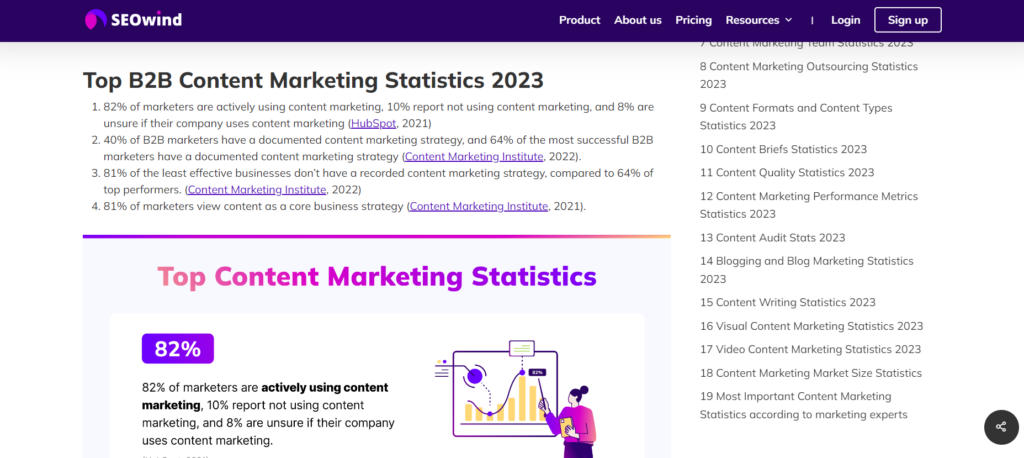
Compilation of up-to-date, current data around (no older than 2020) – thanks to thorough research of dozens of sources. It presents only relevant and timely info. From statistics about content marketing goals towards content marketing tactics and formats to content writing statistics, this data offers insights into what successful digital markets are doing right now. It also provides predictions of where they might go next year.
7 Essential Elements of a Successful Pillar Page

Let’s delve into these seven crucial components of an exemplary pillar page.
Page Title
The first element to pay attention to is the page title. The title should be optimized for search engines and crafted to grab your target audience’s attention. This means utilizing relevant keywords – such as “pillar page examples” or “best pillar page practices” – while keeping it concise and appealing.
Good practice starts by noting potential title variations before settling on the most suitable one. Remember that a powerful title will entice users to click on your content, making them more likely to explore further.
Ungated, Long Form Content
Unlike downloadable assets like e-books or whitepapers that require contact information in exchange for access, ungated content provides value openly without restrictions. Offering long-form content freely attracts more visitors and helps build trust with your audience.
In addition, long-form content improves your chances of ranking higher on search engine results pages (SERPs) because it offers comprehensive knowledge about a specific topic. Aim for at least 2000 words (if not more) depending on the subject matter.
Organized Content Sections
Breaking your content into well-organized sections allows users to navigate your pillar page effortlessly. Use headings and subheadings strategically throughout the piece to guide readers through different topics coherently.
Formatting techniques like:
- Bullet points
- Ordered lists
- Tables
can be employed to make complex ideas accessible and easy to understand for any reader.
Internal Links & Navigation
To elevate user experience further, include internal navigation features such as:
- Jump links or anchor tags – allowing users to skip directly to specific sections of your content.
- Fixed side-navigation menus – ensuring effortless browsing no matter where the reader is on the page.
These features keep users engaged with your pillar page and help them digest information more efficiently.
Internal and External Resource Linking
Incorporating hyperlinks to other valuable content, internally within your website or externally to reputable sources, further establishes authority while providing readers with additional learning materials. The primary aim should be for users to gain as much insight as possible about a topic without leaving your pillar page. Moreover, an internal linking strategy contributes significantly to SEO performance by creating a robust site structure.
Calls to Action (CTA)
Although the main objective of a pillar page is to impart knowledge, it’s equally important to remember conversion opportunities. Relevant CTAs placed strategically throughout the content can entice users down the marketing funnel toward becoming prospects or customers.
Consider using text-based CTAs blended within the content that direct users to sign up for newsletters, download resources, or request consultations – all practical methods of generating qualified leads.
Main Website Navigation
Finally, ensure seamless integration between your pillar page and the rest of your website through clear navigation options such as header menus or breadcrumbs wherever necessary. Doing so allows visitors impressed by your informative pillar pages to explore other sections of your website easily. Consequently, this nurtures relationships with potential clients and builds loyalty over time.
How To Create Your Own Pillar Page

Now that you’ve seen various pillar page examples, it’s time to consider incorporating this powerful content strategy into your digital marketing plan. Before diving in, consider the following steps to ensure success:
- Identify a relevant core topic: Reflect on your target audience and their needs. Choose a broad subject closely related to your industry where you possess a wealth of knowledge, allowing you to produce valuable insights and information.
- Perform keyword research: Identify appropriate long-tail keywords with high search volume and low competition around your core topic. This will help guide the creation of subtopics for your pillar page.
- Organize content into multiple topic clusters: Develop comprehensive subtopics based on the keywords identified earlier, ensuring they are logically connected to your core subject.
- Create engaging content: Write compelling and informative content for the main pillar page and each cluster within it, providing users with an immersive experience that keeps them returning for more.
- Link interconnected pages: Ensure all relevant internal links connect both subtopic pages (clustered) with the main pillar page – enhancing navigation while boosting SEO value through link-building strategies.
- Optimize with best practices: Adhere to SEO guidelines when working on title tags, meta descriptions, headers (H1-H4), images (using alt text), body copy (short sentences), and other on-page elements essential for ranking well on search engines like Google or Bing.
- Promote your masterpiece: Once your impressive pillar page is complete, share it across social media platforms and email campaigns, or even utilize guest blogging as part of outreach efforts – driving traffic and growing awareness of its existence.
With these steps in mind, take inspiration from the exemplary pillar pages discussed earlier in this article: tailor approaches depending on objectives such as data visualization or storytelling, focus on design elements like navigation and typography, and look for creative ways to engage audiences. Remember, a pillar page is an investment in your digital marketing strategy. Take the time needed to create something exceptional that will resonate with your audience and elevate your content.
Incorporating high-quality, well-organized pillar pages into your content strategy will enhance user experience and strengthen SEO performance. With the right approach and inspiration from these stellar examples, you can confidently forge ahead on this exciting journey toward creating successful pillar pages for your website.
Best Practices for Optimizing Pillar Pages for Search Engines
By following the best practices listed below, you can navigate the intricate world of SEO and establish your pillar page as a fundamental aspect of your digital presence.
Use Descriptive and Optimized Meta Titles and Descriptions
Firstly, pillar pages must have descriptive meta titles and descriptions. This means creating unique, engaging descriptions for both areas that succinctly describe the content on your page. The relevance of this metadata cannot be overstated. Search engines use it when indexing pages, affecting how well your page ranks.
Incorporating relevant keywords into your meta title and description helps search engines understand what your webpage offers users. These elements should attract clicks and paint an accurate picture of what one can expect from delving into your pillared content.
Add Proper Heading Tags (H1, H2, H3) to Structure Your Content
Secondly, consider the role structuring plays in readability. Using proper HTML tags like H1 for main headings and subsequent H2 or H3 for subheadings helps readers and search engine crawlers easily interpret information hierarchy within a post.
This serves two essential functions: First, it improves user experience by making content easily digestible at a glance and helping readers navigate through sections smoothly. Secondly, correctly using heading tags directly influences how search engine spiders identify crucial subject matter on your pillar page.
Include Internal Links to Other Related Content on Your Website
Internal linking forms another stepping stone toward a robust SEO strategy for pillar pages. By including links pointing towards relevant blog posts or articles within your website – typically under related subtopics – you’re effectively guiding visitors down their informational journey while keeping them engaged with more of your high-quality material.
But more than just enhanced user experience, this action helps distribute page authority throughout your site. More link equity passed naturally through internal links significantly influences the overall SEO strength of all pages involved.
Optimize Your URL Structure for Better Visibility
Just as meta titles and headings aid clarity and comprehension, an optimized URL structure carries weight in SEO matters. Simplified, concise URLs that directly reflect the associated webpage topic not only enhance user experience – but also contribute to improved search engine recognition.
Remember that a well-structured URL should avoid unnecessary dates or numbers and ideally incorporate relevant keywords. A straightforward URL allows search engines like Google to index such pages firmly under appropriate categories.
Incorporate Relevant Keywords Throughout Your Pillar Page
A masterstroke strategy when refining pillar pages follows the judicious use of relevant keywords throughout your content. Keywords work as indicators to readers and search engines about your page’s essence – so their tactical inclusion often translates into better visibility on SERPs (Search Engine Results Pages).
Ensure these keywords fit naturally within the overall text flow so it does not appear forced or spammy. User experience must remain at the forefront; successful SEO pillar pages never sacrifice readability for keyword density.
Make Your Pillar Page Mobile-Friendly and Optimized for Speed
Lastly, ensuring your pillar page is mobile-friendly and lightning-fast is the best secret to excelling in this game. A slow loading speed will result in higher bounce rates. In contrast, a non-mobile-friendly design could miss out on valuable traffic from handheld device users.
Not forgetting Google’s mobile-first indexing policy, where it primarily uses the mobile version of content for indexing and ranking since the majority of Internet users now browse via smartphones. Prioritizing these aspects gets your content favored by search algorithms, thus helping refine pillar pages to be reachable assets within your overarching strategy.
Remember: Effective implementation of the above-listed best practices is expected to put you above your industry competition. This shifts you from learning to mastering SEO optimization for pillar pages, eventually gifting better visibility, high traffic, and preferred SERP rankings.
Pillar Pages FAQ

Below we’ll address some common questions related to pillar pages, their creation process, and their role in boosting your content strategy. To provide comprehensive answers, I have incorporated several relevant keywords such as “what is a pillar page,” “how many pillar pages you should have,” and “how to write a good pillar page”. Let’s dive into these frequently asked questions.
What Is a Pillar Page?
A pillar page is an extensive piece of content that covers all aspects of a core topic on a single webpage. It is the foundation for a larger content strategy, where multiple sub-topics branch out from the central theme. These supporting pieces of content are known as cluster posts or subtopic posts. The main goal of creating a pillar page is to improve website organization, enhance user experience, and boost search engine optimization (SEO) efforts.
What are good pillar pages?
Great pillar pages are comprehensive resources on a specific topic that serves as the foundation for other relevant pieces of content on your website. These well-designed pages cover all aspects of a subject matter comprehensively yet concisely enough to keep readers engaged while providing significant value. Here are some features that set good pillar pages apart:
- Informative and educational: A high-quality pillar page is loaded with valuable information for its target audience, imparting knowledge that establishes you as an expert in the field.
- Visually appealing: The design should be clean and easy to read using images or multimedia elements such as videos or infographics to enhance user experience.
- Easy navigation: Good pillar pages utilize clear headings and subheadings to facilitate smooth browsing through diverse sections while ensuring relevance. They often utilize the table of contents.
- SEO-optimized: Effective pillar pages consider human audiences and search engines by incorporating strategically placed keywords within headers and throughout the text without appearing unnatural or forced.
- Internal links: Linking internally creates a cohesive web of related blog posts, funneling users seamlessly across pertinent information around the central topic on the pillar page.
- Content authority: Successful pillar pages gather trust and credibility by citing authoritative sources such as studies, reports, and reputable experts in the industry to substantiate claims made within the content.
By incorporating these key factors into your pillar page strategy, you’ll be well on your way to creating engaging and effective pillars that boost your content marketing efforts.
How long should pillar pages be?
The ideal length of a pillar page can vary based on factors such as industry, target audience, and the topic being covered. However, it’s essential to provide comprehensive and in-depth information that offers significant value to your readers. With this in mind, a well-researched, high-quality pillar page often ranges from 2,000 to over 10,000 words.
There are several reasons for creating longer, in-depth content pieces:
- Covers various aspects of a topic: Lengthier pillar pages are advantageous because they cover multiple dimensions of a given subject matter, offering readers detailed insights.
- Improves SEO ranking: Google tends to prioritize longer content pieces as they’re more likely to provide users with valuable information. A well-written pillar page benefits from increased search visibility and helps boost your website’s credibility among users and other stakeholders within your niche.
- Encourages audience engagement: Longer content typically results in higher levels of reader engagement because it offers extensive knowledge on a particular topic. This, in turn, increases the likelihood of visitors spending more time on your website and exploring other related resources.
It would be best if you didn’t prioritize word count at the expense of quality or readability. Be sure to maintain an organized structure and avoid redundancy wherever possible. Ideally, aiming for greater depth while ensuring each section brings unique value or additional insights into the subject matter would be best.
Remember that these guidelines aren’t set in stone. Instead, use them as reference points when determining the optimal length for your pillar pages. Most importantly, consider elements such as purpose, audience needs, and overall impact to create unique long-form content as a cornerstone for your broader content marketing strategies.
How Many Pillar Pages Should You Have?
The ideal number of pillar pages for your website depends on your business goals, target audience coverage, and resources available for content creation. A general rule of thumb is to create one pillar page per primary topic you want to focus on within your industry or niche. This approach allows you to establish authority over those topics. It gives search engines clear signals about the relevance and organization of your content.
To determine the right number of pillars for your specific needs, analyze your existing keyword research data and identify overarching themes in your target market’s search queries. From there, map each piece onto a separate pillar page idea.
How To Write A Pillar Page?
Writing an effective pillar page requires thoughtful planning, thorough research, clear communication skills, and attention to SEO best practices. Here are some steps that can guide you through the process:
- Begin by identifying primary topics aligned with both your target audience’s needs and your area of expertise.
- Conduct extensive research into pertinent information, data, and perspectives related to those primary topics.
- Outline a comprehensive structure for the pillar page, breaking down the subject matter into multiple sub-topics or chapters.
- Write engaging, informative content for each section while maintaining a cohesive narrative.
- Incorporate relevant keywords naturally throughout the text to enhance your SEO performance.
- Create visual elements such as graphics, images, charts, or tables to support written material and make it more digestible for readers.
- Optimize navigation and user experience by incorporating clear headings and subheadings, intuitive menu options, table of contents, and internal links connecting to other relevant pages on your site.
By following these steps and embracing a well-structured approach guided by your audience’s needs and preferences, you’ll be able to craft an impressive pillar page that becomes central to your website’s content strategy success.
What should be on a pillar page?
A well-designed and informative pillar page incorporates several crucial aspects that enhance its usefulness and authority. Here are some of the must-have elements on each pillar page:
- A relevant and engaging title: The title is the first thing your audience will see. It should convey the topic being discussed and entice readers to proceed further.
- Ungated, long-form content: Ensure your pillar content is comprehensive and accessible without requiring users to provide personal information or sign-up.
- Organized content sections with headings: Divide your lengthy content into easily digestible sections, using clear headings and subheadings to guide readers through various topics.
- Internal navigation system: Help users find specific sections of interest quickly by providing an internal navigation menu or anchor links within your content.
- Internal and external resource linking: To boost credibility and relevance, include valuable internal links to related articles or resources on your website and external links to authoritative third-party sources.
- Calls-to-action (CTAs): Strategically place CTAs throughout your content to encourage users to take further action – such as subscribing to a newsletter or downloading a relevant offer – after consuming the information provided.
- Main website navigation integration: Always keep seamless user experience in mind by ensuring visitors can easily navigate to other areas of your website from the pillar page.
By incorporating these vital elements, you are ensuring that your pillar pages provide comprehensive knowledge on their respective subjects, engage users, facilitate seamless navigation and browsing, and establish your website as a reliable source of valuable information.
Remember that when creating pillar pages, following SEO best practices will further enhance the page’s discoverability, ensuring optimal visibility in search results. Combining high-quality content, user-focused design, and proper content optimization sets successful pillar pages apart from the crowd.
